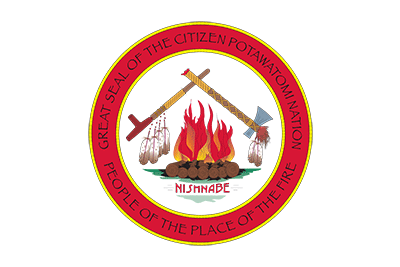Potawatomi Nation Seal
 The first Tribal Seal was created in the 1970s by Secretary/Treasurer Beverly Hughes. It was a black circle with “Great Seal of the Citizen Band of Potawatomi Indians of Oklahoma” inside the edge and featured a crossed Cherokee-style pipe and tomahawk over a fire with three logs.
The first Tribal Seal was created in the 1970s by Secretary/Treasurer Beverly Hughes. It was a black circle with “Great Seal of the Citizen Band of Potawatomi Indians of Oklahoma” inside the edge and featured a crossed Cherokee-style pipe and tomahawk over a fire with three logs.
When the Tribe changed its name in 1996 to the Citizen Potawatomi Nation, a new seal was needed. Drawn in 1995 by Chairman John Barrett in pen, ink and colored pencil, the design was standardized in 2003. The Tribal Seal’s red circle symbolizes the Great Circle of Life — Gzhemnedo or Mamogosnan’s (God’s) great pattern for all things.
All of God’s creations move through their existence clockwise, like the sun and the moon, in a great circle from light to dark, living world to spirit world and back. All living things have a life force, a “fire” — the energy that makes cells divide, that returns undiminished at death to Sugamukwe (Mother Earth) and later emerges into the light in the life force of other living things. Every beginning has an end. Every end is a beginning.
Red is the color of Wetchnowkwek, the South, symbolizing the direction of procreation, the women’s direction. All living things are born of a mother. South is the direction of KehTahMah GehNinGahWin, the Spirit of Compassion, a mother’s great strength. The red circle is surrounded on both edges by a yellow rope.
Yellow is the color of WetchMoKuk, the East, the direction of BwaKahWin, the Spirit of Wisdom. The first wisdom was the original man’s knowledge of God’s Great Plan in the Circle of Life: The life of one living thing is related to the life of all other living things, never-ending. Wisdom should surround the decisions of our tribal government. Underlying the Great Seal is the color white, the color of WetchKehSimYok, the North, symbolizing MeanGoWin — the Spirit of Generosity and giving. Giving must be the motive underlying tribal governance.
The top of the field shows a Pwagen (Pipe) crossed with a WaGakWaDoan (Tomahawk) to form the shape of a roof or shelter over the fire. The Tribe must shelter and protect its people. The Pwagen’s pipestone bowl holds the burning tobacco. Smoke is drawn through the stem to send up in prayer. The Pwagen on the Great Seal means we pray for the good of our people, and believe in the power of prayer. The Pwagen carries four eagle feathers, symbolizing the Four Directions and the Four Spirits that God intended mankind to carry in his character. The Tomahawk symbolizes our commitment to defend our Tribe, and our history of doing so.
The blade up shows we are not at war. The Tomahawk carries two eagle feathers, symbolizing the two inner natures, the two genders of mankind, and the two halves of existence in the Great Circle of Life — the living world and the spirit world, the light and the dark. Kno (the Eagle) is God’s messenger. When it sees prayer smoke rising from the fires of the Nishnabe, and the sun rises for another day, it calls out to the Creator that the faithful still inhabit Mother Earth.
The fire symbolizes the Bodewadmi, later pronounced Potawatomi. It means “People of the Fire.” In the old Medewin religion, we are the Keepers of the Fire in the Three Fires of the Nishnabe — the Potawatomi, Ojibwe, and Odawa (Ottawa) Tribes. The fire symbolizes the power or essence of life that is never diminished, but simply changes form as living things travel from the living world to the spirit world. The fire also symbolizes the two natures we all have inside of us, good and evil. Only humans can choose between the two. The fire has seven logs symbolizing the Seven Prayers of the Pwagen (Pipe) Ceremony.
Nishnabe, means “the People.” The Nishnabe are made up of the Potawatomi, Ojibwe, and Odawa (Ottawa) Tribes. We are one blood and one original language. We traveled as one in the migration from the Atlantic Ocean near Nova Scotia to the Great Lakes in the 1300s.
The name sits on a bed of green symbolizing that we will live on as a people as long as the grass grows.






